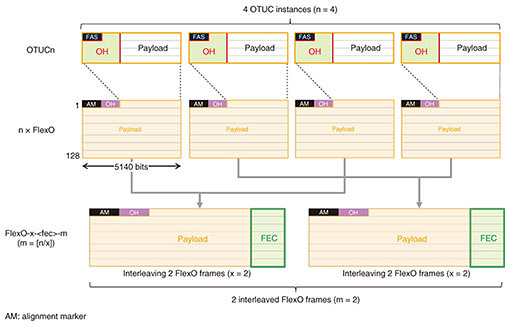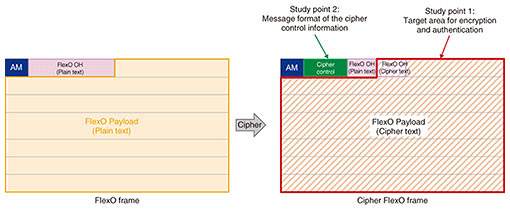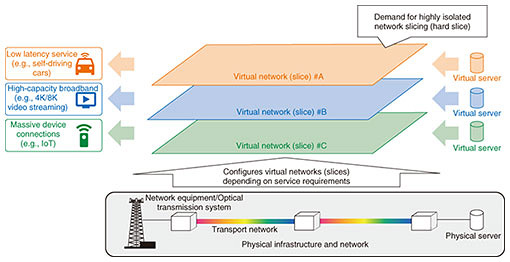 |
|||||||
|
|
|||||||
|
Global Standardization Activities Vol. 18, No. 12, pp. 103–108, Dec. 2020. https://doi.org/10.53829/ntr202012gls Trends in Standardization of Mapping and Multiplexing Technologies for Optical Transport NetworksAbstractThis article introduces recent standardization activities in the International Telecommunication Union - Telecommunication Standardization Sector (ITU-T) related to optical transport networks, including fifth-generation mobile transport networks. Keywords: OTN, OTN security, 5G mobile transport 1. IntroductionThe International Telecommunication Union - Telecommunication Standardization Sector (ITU-T) Study Group 15 Question 11 (Q11/15) have addressed the standardization of framing and multiplexing technologies for optical transport networks (OTNs) used in the backbone networks of telecommunication carriers. Of particular note, the OTN specified in ITU-T Recommendation G.709 has been widely applied to optical transmission systems as key technology to achieve long-distance and large-capacity transmission as well as cost reductions. Therefore, NTT has been extensively contributing to OTN standardization activities. Section 2 outlines the OTN, specifically, the basic and latest framing/multiplexing technologies. Section 3 explains Flexible OTN (FlexO), an enhanced interface that provides flexibility and scalability. Security has also become important in transmission networks, and Section 4 describes OTN and FlexO encryption technologies. Section 5 explains fifth-generation (5G) mobile transport networks. Finally, Section 6 introduces future activities. 2. OTN multiplexing and mapping structureAn OTN has two functions; (1) packaging various client signals into OTN frames and (2) multiplexing OTN frames into a higher-speed OTN frame (see Fig. 1). As shown in Fig. 2(a), an optical channel transport unit-k (OTUk) frame (k = 1,2,3,4) uses the fixed frame of 4 × 4080 bytes and contains three areas; the payload area accommodates the client signal, overhead (OH) area carries maintenance and control information, and forward error correction (FEC) area transfers redundant data to correct the bit errors that may occur during transmission. The OH area in Fig. 2(a) consists of three regions, optical payload unit (OPU) OH, optical data unit (ODU) OH, and optical transport unit (OTU) OH. The OPU OH includes information that supports the adaptation of client signals, ODU OH includes information for maintenance and operational functions to support ODU connections, and OTU OH includes information for maintenance and operational functions to support OTU connections.
The OTN was originally standardized in 2001 with three bitrate classes, OTU1 (2.67 Gbit/s), OTU2 (10.7 Gbit/s), and OTU3 (43.0 Gbit/s) to accommodate synchronous digital hierarchy (SDH), which was the dominant client signal at that time. Next, OTU4 (112 Gbit/s) was specified in 2010 to transport 100 Gigabit Ethernet (100GbE) [1]. Subsequently, with the development of higher-speed client signals, such as the 200GbE and 400GbE specified in the Institute of Electrical and Electronics Engineers (IEEE) 802.3, Q11/15 began discussing an OTN for rates beyond 100 Gbit/s (Beyond 100G; B100G). The B100G OTN takes into account flexibility and extensibility, which are considered important features in addition to transmission capacity. Therefore, the optical channel transport unit-Cn (OTUCn) frame (The index Cn is used for n × 100G (C = 100G); n is a positive integer) was specified to have an n multiplexing structure that concatenates OTUC frames that have 100G transmission capacity, as shown in Fig. 2(b). The OTUCn frame also supports multi-carrier transmission by using multiple optical signals (wavelengths) in parallel, and the optical interface can be configured flexibly by multiplexing OTUC frames according to the transmission speed per optical signal. The FEC area, which is one of the characteristic functions of the OTUk frame, is separate from the OTUCn frame and is specified not in G.709 but in G.709.1, G.709.2, and G.709.3. This is because it is necessary to specify the optimum FEC coding scheme and area according to the physical transmission speed of the optical signal. The next section describes how to transmit OTUCn frames in combination with FEC.
3. OTN enhancementsStandardization activities have recently progressed towards aggregating multiple physical interfaces to configure large-capacity links. A well-known example of aggregated virtual links is the Link Aggregation Group (LAG) of IEEE802.3ad, which bonds Ethernet physical interfaces. For example, a 400-Gbit/s aggregated link can be configured by bonding four 100GbE interfaces with this LAG. However, the bandwidth of a data flow is limited to that of the physical interface since each single data flow is transported via only one of the physical interfaces. In this 400-Gbit/s-link LAG, a single flow cannot exceed 100 Gbit/s. This limitation between the data flow and physical interface can induce traffic imbalances on some physical links. Therefore, it remains difficult to efficiently use the large-capacity link configured using the LAG. To overcome this challenge, the Optical Internetworking Forum (OIF) standardized Flexible Ethernet (FlexE) in 2016. FlexE configures large-capacity links by bonding multiple Ethernet physical interfaces similar to the LAG, but it can freely provide logical channels across multiple physical interfaces. The logical channel acts as an Ethernet link equivalent to a real physical interface, as shown in Fig. 3.
In Q11/15, FlexO, which bonds multiple physical interfaces, was specified in Recommendation G.709.1 in 2017. FlexO transfers OTUCn, making the optical transmission flexible and scalable from both logical and physical aspects. Figure 4 shows an example of G.709.1; one OTUCn frame is mapped into n × FlexO frames, with each FlexO frame containing one OTUC frame. The n × FlexO frames are combined, interleaved, and mapped into FlexO-x-<fec>-m (m = [n/x], where [ ] is the ceiling function). For example, an OTUC4 frame can be transported using two 200G FlexO frames (m = 2, x = 2) or a single 400G FlexO frame (m = 1, x = 4). Since it is assumed that FlexO will be applied to communication between adjacent network equipment, G.709.1 adopted KP4 FEC (RS10(544,514)) as FlexO FEC (-<fec>-), which is the same as that of 200G and 400G Ethernet, which have transmission distances of up to 10 km.
NTT has been actively involved in and contributing to FEC discussions, believing that it is necessary to specify an FEC for metro and long-distance transmission to apply OTUCn/FlexO to practical OTNs. We took a leadership role in standardizing the best FEC possible. For example, we summarized various opinions from many network service providers and vendors and submitted many contribution documents to Q11/15 and Question 6 (Q6/15). In addition to standardization activities, NTT also has conducted and demonstrated inter-operability verification trials on a candidate FEC between optical devices developed by different vendors. After more than five years of these activities, Staircase FEC was successfully standardized in 2018 as 100G FlexO FEC (Recommendation G.709.3). At the same time, Staircase FEC was also adopted as the FEC for long-reach OTU4 application in Recommendation G.709.2. NTT has also played a major role in open FEC (OFEC) standardization for 450-km 200G/400G FlexO applications (G.709.3 in 2020). OFEC is also adopted by the Open ROADM (reconfigurable optical add/drop multiplexer) Multi-Source Agreement (MSA). 4. OTN secure transmissionDue to the recent worsening of security risks, Q11/15 began discussing OTN cryptographic standardization, which covers two functions: encryption to prevent wiretapping and authentication to verify if the received frames were tampered with. Prior to the standardization study, there was a discussion about the order in which to proceed with the standardization. Since FlexO OH can carry more cryptographic control information than OxU (OPU/ODU/OTU) OH and it seemed easy to study, Q11/15 decided to start with FlexO encryption. OxU encryption will follow after FlexO. Figure 5 illustrates FlexO frame encryption. The encryption area of FlexO consists of a payload region and a portion of the OH region. With regard to the encryption algorithm, it has been agreed to adopt a current algorithm (e.g., Advanced Encryption Standard (AES)*) rather than develop new ones. Studies and discussion are still on-going, but agreement in the near future seems likely.
5. Slicing techniques for 5G mobile transport networkOne of the characteristic requirements for 5G mobile networks is network slicing (Fig. 6 [2]). Network slicing involves managing physical equipment (physical resources), such as servers and routers, as resources that can be partitioned virtually (virtual links, virtual network functions, etc.).
In Q11/15, these network-slicing requirements are specified in G.8300; it summarizes the requirements for 5G mobile transport networks and a new multiplexing technology, tentatively called Metro Transport Network (MTN). MTN requires strongly isolated network slicing (hard slicing) to prevent interference among slices that access the common physical network. Two candidate techniques have been proposed to achieve hard slicing; one is an OTN-based technique and the other is a FlexE-based technique. In the former, the payload area of high-speed OTN frames is divided into small areas called time slots, and low-speed frames are allocated to them so that hard slicing can be achieved by treating the OTN time slots as virtual resources. In the latter, the logical channel is used to implement hard slicing. These two techniques are specified in Supplemental G.sup.67. 6. Future activitiesOTN technologies, which play important roles in the information society, will become even more important. NTT will continue contributing to standardization activities in ITU-T while staying informed about technological trends in optical transmission and advancing discussions in other standardization bodies and MSAs. References
|
|||||||









